In the realm of music consumption, two dominant formats have coexisted for decades: vinyl records and digital audio. Each format has its distinct characteristics, and enthusiasts often debate the merits of one over the other. In this comprehensive article, we will explore the key differences between vinyl and digital audio, offering insights into their respective qualities, how to identify them, and the subjective nature of the listening experience.
Vinyl Records: The Analog Warmth
Vinyl records are the embodiment of analog audio. They use physical grooves on a vinyl disc to represent sound waves. Here are some characteristics that set vinyl apart:
- Analog Warmth: Vinyl is celebrated for its warm and natural sound quality. Analog recordings capture subtle nuances, offering a richness that many listeners find appealing.
- Tactile Experience: Handling vinyl records involves a tactile experience, from gently placing the needle on the groove to flipping the record to the other side. The large album covers and liner notes add to the physicality of vinyl.
- Imperfections: Vinyl records are not without their imperfections. Surface noise, pops, and clicks are part of the vinyl charm, stemming from the physical nature of the format.
- Limited Dynamic Range: The dynamic range of vinyl is limited compared to digital formats, which can result in reduced loudness and a more nuanced listening experience.
- Frequency Response: Vinyl has a unique frequency response curve, with slight roll-offs in the high and low frequencies. This can impart a distinctive tonal character to the music.
Digital Audio: Precision and Convenience
Digital audio, on the other hand, relies on digital encoding and playback technology. Here are some characteristics that define digital audio:
- Precision: Digital audio offers high precision and accuracy in reproducing sound. It is capable of capturing and reproducing even the subtlest details of a recording.
- Consistency: Digital audio is consistent in its playback, with minimal variations between different listening sessions. It is largely immune to the wear and tear that can affect vinyl records.
- Convenience: Digital music is highly portable and easily transferable between devices. It can be accessed and streamed from various platforms with convenience.
- Dynamic Range: Digital audio boasts an extended dynamic range, providing a wide spectrum of loudness levels and ensuring that no detail is lost in complex musical passages.
- Low Noise: Digital formats are inherently free from the surface noise, pops, and clicks that are characteristic of vinyl records.
Distinguishing Between Vinyl and Digital:
- Physical Medium: The most obvious way to distinguish between vinyl and digital is by the physical medium. Vinyl records are tangible, flat discs with grooves, while digital audio is stored as files or streamed online.
- Playback Equipment: The equipment used for playback is a significant indicator. Turntables with tonearms, cartridges, and styluses are used for vinyl, whereas digital audio is played through computers, CD players, or digital audio players.
- Sound Characteristics: Listening closely can reveal differences in sound characteristics. Vinyl often exhibits warmth and occasional surface noise, while digital audio is typically free from these characteristics and offers greater clarity.
- Visual Indicators: Digital audio files typically display on-screen information such as file formats (e.g., MP3, FLAC) and playback time. Vinyl records feature grooves, labels, and large album artwork.
- Playback Controls: Digital audio allows for precise playback controls, such as fast-forwarding, rewinding, and shuffling, which are not possible with vinyl records.
Subjectivity and Personal Preferences:
It’s crucial to recognize that the distinction between vinyl and digital audio isn’t solely about objective qualities; it also involves subjective preferences. Some listeners gravitate toward the tactile and analog experience of vinyl, while others prefer the convenience and precision of digital audio. Ultimately, the choice between vinyl and digital audio is a matter of personal taste and the qualities that resonate most with individual listeners.
The distinction between vinyl and digital audio is marked by their respective characteristics, physical forms, and listening experiences. While they offer distinct qualities, both formats have their place in the world of music consumption. Enthusiasts and music lovers can enjoy a tapestry of listening choices, embracing the warmth of vinyl, the precision of digital audio, or a combination of both, depending on their preferences and the music they cherish. The beauty of music lies in its diversity, and both vinyl and digital audio contribute to the rich mosaic of musical enjoy


